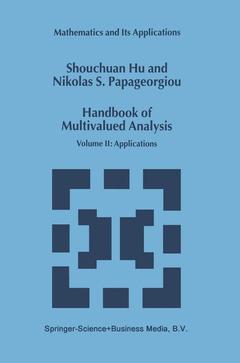Description
Handbook of Multivalued Analysis, 2000
Volume II: Applications
Mathematics and Its Applications Series, Vol. 500
Authors: Shouchuan Hu , Papageorgiou Nikolaos S.
Language: English
Approximative price 158.24 €
In Print (Delivery period: 15 days).
Add to cart
Handbook of Multivalued Analysis
Publication date: 12-2013
932 p. · 15.5x23.5 cm · Paperback
Publication date: 12-2013
932 p. · 15.5x23.5 cm · Paperback
Approximative price 158.24 €
Subject to availability at the publisher.
Add to cart
Handbook of multivalued analysis vol 2 applications (Mathematics & its applications 500)
Publication date: 01-2000
932 p. · 16x24 cm · Hardback
Publication date: 01-2000
932 p. · 16x24 cm · Hardback
Description
/li>Contents
/li>
In volume I we developed the tools of "Multivalued Analysis. " In this volume we examine the applications. After all, the initial impetus for the development of the theory of set-valued functions came from its applications in areas such as control theory and mathematical economics. In fact, the needs of control theory, in particular the study of systems with a priori feedback, led to the systematic investigation of differential equations with a multi valued vector field (differential inclusions). For this reason, we start this volume with three chapters devoted to set-valued differential equations. However, in contrast to the existing books on the subject (i. e. J. -P. Aubin - A. Cellina: "Differential Inclusions," Springer-Verlag, 1983, and Deimling: "Multivalued Differential Equations," W. De Gruyter, 1992), here we focus on "Evolution Inclusions," which are evolution equations with multi valued terms. Evolution equations were raised to prominence with the development of the linear semigroup theory by Hille and Yosida initially, with subsequent im portant contributions by Kato, Phillips and Lions. This theory allowed a successful unified treatment of some apparently different classes of nonstationary linear par tial differential equations and linear functional equations. The needs of dealing with applied problems and the natural tendency to extend the linear theory to the nonlinear case led to the development of the nonlinear semigroup theory, which became a very effective tool in the analysis of broad classes of nonlinear evolution equations.
Preface. I. Evolution Inclusions Involving Monotone Coercive Operators. II. Evolution Inclusions of the Subdifferential Type. III. Special Topics in Differential and Evolution Inclusions. IV. Optimal Control. V. Calculus of Variations. VI. Mathematical Economics. VII. Stochastic Games. VIII. Special Topics in Mathematical Economics and Optimization. Appendix. References. Symbol. Index. Errata of Volume A.
© 2024 LAVOISIER S.A.S.




